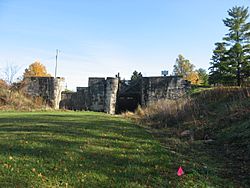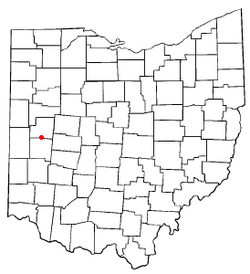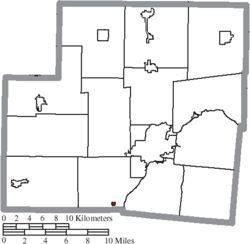Lockington, Ohio facts for kids
Quick facts for kids
Lockington, Ohio
|
|
|---|---|
|
Village
|
|

One of the Lockington Locks
|
|

Location of Lockington, Ohio
|
|

Location of Lockington in Shelby County
|
|
| Country | United States |
| State | Ohio |
| County | Shelby |
| Government | |
| • Type | Mayor-Council |
| Area | |
| • Total | 0.08 sq mi (0.22 km2) |
| • Land | 0.08 sq mi (0.22 km2) |
| • Water | 0.00 sq mi (0.00 km2) |
| Elevation | 929 ft (283 m) |
| Population
(2020)
|
|
| • Total | 162 |
| • Density | 1,928.57/sq mi (740.39/km2) |
| Time zone | UTC-5 (Eastern (EST)) |
| • Summer (DST) | UTC-4 (EDT) |
| FIPS code | 39-44352 |
| GNIS feature ID | 2398463 |
Lockington is a small village located in Shelby County, Ohio, United States. It sits along Loramie Creek. The village was originally called Locksport. In 2020, about 162 people lived there.
Contents
History of Lockington
Early Mills and Community Growth
Around 1830, a flour mill was built near where Lockington is today. This mill helped grind grain into flour. Before that, there was an old sawmill on the same creek that was no longer used.
By 1837, a man named John Brown owned both of these mills. He also built a new wool mill. A small community started to grow around these mills. More mills were built along Loramie Creek over time.
The Miami and Erie Canal
The Miami and Erie Canal was very important for Lockington. When the canal was built, a special series of 5 canal locks were created. These locks lifted the canal water 60 feet over the creek. This was done using a structure called an aqueduct.
Because the community was so close to these locks, it was first named Locksport. The canal was a major pathway for trade and travel. Lockington became a busy crossroads. It connected the main canal with smaller channels from Port Jefferson and Sidney. This helped the community grow even more.
Founding and Development
In 1837, David Mellinger hired Jonathan Counts to map out a new community on his land. This process is called "platting." The community of Lockington was officially approved as a village on September 9, 1857. This approval came from the Shelby County Commissioners.
The first elections in Lockington happened on April 1, 1858. W. S. Burns was elected as the first mayor. The Lockington Post Office opened on June 28, 1847.
Around 1845, William Stephens built the first sawmill in Lockington. A new and improved mill was built on the same spot in 1860. This mill was used to grind grain. It changed owners over the years but kept working until it burned down around 1900.
Businesses and Modern Times
About 1905, D.K. Gillespie built a grain elevator in the village. This was a large building for storing grain. In 1912, a new owner, C.N. Adlard, made it even bigger. It became one of the largest grain elevators in Ohio.
By 1913, Lockington also had two general stores, a machine shop, and a seasonal ice cream shop. There was also a local group called Knights of the Maccabees Tent No. 68. The post office closed on August 30, 1914. Mail service for Lockington now comes from Piqua. Today, the original locks are part of the Lockington Locks Historical Area.
In 2019, Lockington received a special grant. This grant helped the village organize and share its historical documents.
Geography of Lockington
Lockington is a very small village. According to the United States Census Bureau, the village covers a total area of about 0.08 square miles (0.22 square kilometers). All of this area is land.
Population and People
| Historical population | |||
|---|---|---|---|
| Census | Pop. | %± | |
| 1870 | 214 | — | |
| 1880 | 219 | 2.3% | |
| 1890 | 170 | −22.4% | |
| 1900 | 210 | 23.5% | |
| 1910 | 166 | −21.0% | |
| 1920 | 181 | 9.0% | |
| 1930 | 174 | −3.9% | |
| 1940 | 192 | 10.3% | |
| 1950 | 245 | 27.6% | |
| 1960 | 263 | 7.3% | |
| 1970 | 242 | −8.0% | |
| 1980 | 203 | −16.1% | |
| 1990 | 214 | 5.4% | |
| 2000 | 208 | −2.8% | |
| 2010 | 141 | −32.2% | |
| 2020 | 162 | 14.9% | |
| U.S. Decennial Census | |||
Population in 2010
In 2010, the census showed that 141 people lived in Lockington. There were 56 households, which are groups of people living together. Most of the people living in the village were White.
The average age of people in Lockington was about 44.8 years old. About 22% of the residents were under 18 years old. Most households were married couples living together.
See also
 In Spanish: Lockington (Ohio) para niños
In Spanish: Lockington (Ohio) para niños

